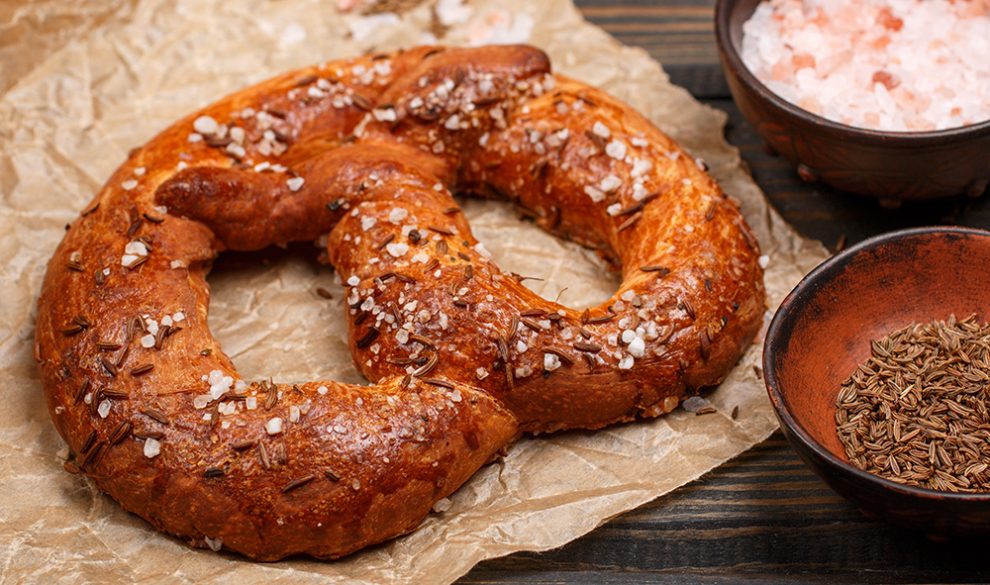Caraway is a spice that we should all be growing along with our parsley and chervil because it’s so versatile. It has a very strong anise flavour like fennel, which some people love, and others dislike, but it may be that they just haven’t tried it with the right foods yet.
Caraway (Carum carvi), is a biennial plant (meaning it only lives for 2 years) also known as meridian fennel or Persian cumin. It is in the carrot or Apiaceae family and the plant looks like others in the carrot family, which includes parsley. It’s native to western Asia, Europe and Northern Africa, and nearly 30% of the world’s caraway is grown in Finland, thriving in its long but cool summer days.
Caraway leaves are aromatic, fine and feathery and have thread-like divisions, growing on 20–30 cm stems. The main flower stem is 40–60 cm tall, with small but pretty white or pink flowers in flat umbels. Although you can grow it in a herb or vegetable garden, it will also look lovely mixed in with cottage border plants.
Caraway thrives in full sun in cooler, temperate climates and seeds can be planted in spring after the last frost or in early autumn in light, well-drained soil. Although you can start off the seed indoors in cold climates and plant them out when they’re young, as it develops a taproot with age, it doesn’t do well in containers and becomes difficult to transplant.
Keep your caraway plant well-watered during the first summer and give it a small amount of fertiliser. But, as caraway doesn’t like humidity, try and avoid wetting the leaves with overhead watering. Once the caraway plant is into its second summer, it’s much more drought hardy.
During that first year you can harvest some of the leaves, which have a fresh but slightly bitter taste, to use like you would parsley, including tossed through a green salad.
Over time caraway plants also develop an edible tap root, rather like a parsnip. Although you will want to keep some of your caraway plants into their second year for the seeds, the tap root is softer and sweeter to eat during this first year, so grow quite a few plants so you can harvest some roots now.
It takes it until its second year to develop flower heads, and then another month after flowering for the seeds to develop in the late summer, which are actually are actually fruits, being crescent-shaped achenes, around 2 mm long, with five pale ridges. You can cut the seed heads off the plant as they start to brown off and let them ripen and fall into a paper bag. As it’s biennial, the plant dies after the seeds form. If you leave a few seeds on the plant as it dies, these are likely to germinate for the next season.
Once your caraway plant is dying back, make sure you don’t waste the tap root which is now a bit woodier but you can still add it to a stew or soup.
How to use caraway seed
Caraway seed is an important flavour ingredient in many breads, cakes, pastries, cheeses and soups, as well as sauerkraut, but you can also use it to add flavour in so many dishes, even just sprinkled over cooked fresh green vegetables like beans, peas, zucchini (courgettes) Brussel sprouts and broccoli.
Add some to sour cream that’s spooned over cubed cucumber, to spice up an apple sauce or sprinkle some over beef, lamb or pork that’s ready to roast. Or use your caraway in spice mixes like African harissa or Indian garam masala.
There are also liqueurs flavoured with caraway, like Kummel and schnapps and oil extracted from the seeds is used to add fragrance to soaps and lotions.
Caraway Seed Cake Recipe
Ingredients:
175g (6oz) butter, softened
175g (6oz) caster sugar
3 medium eggs
250g (8oz) self-raising flour
38g jar caraway seeds
2tbsp milk
1kg (2lb) loaf tin, buttered and lined with a strip of baking parchment
Preparation:
Tip all the ingredients into a bowl and beat until smooth. Spoon mixture into the loaf tin and level the surface.
Bake the cake in the centre of the oven 160°C (320°F, gas mark 3) for 45 mins-1 hr, or until the cake feels just firm to the touch in the centre, and a skewer comes out clean when inserted into cake.
Remove the cake from the oven and leave to cool in the tin for 10-15 mins.
Transfer it to a wire rack to cool completely.
Serve with hot English breakfast tea!
About Marianne Cannon
Marianne Cannon has been broadcasting as Real World Gardener on radio 2RRR 88.5fm in Sydney, since September 2009, and the program is now syndicated to radio stations around Australia. It’s about growing your own, the abc of plants, and how to create sustainable gardens to fit into today’s environment. Not just a show about plants; it has a strong green and ecological bent, with co-presenters addressing issues such as native animals and plants, water conservation, composting, reducing waste, protecting native species and more.


























